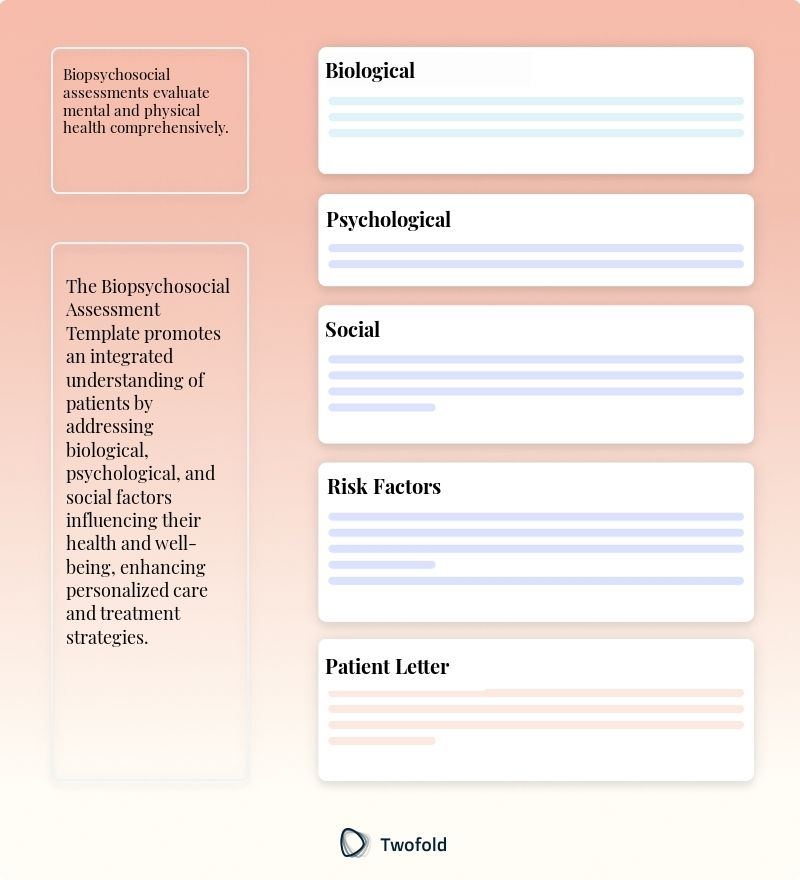
Biopsychosocial Assessment Template
Have you ever found yourself feeling overwhelmed when faced with the task of conducting a biopsychosocial assessment? You're not alone. Many professionals in the healthcare field encounter challenges when trying to gather and analyze a patient's psychological, social, and biological information. This blog post aims to alleviate some of that stress by providing a comprehensive overview of the biopsychosocial assessment template, including expert tips, key components, and real‑world use cases.
What Is a Biopsychosocial Assessment Template?
A biopsychosocial assessment template is a structured tool designed for healthcare providers to evaluate the biological, psychological, and social factors affecting a patient's health. This type of assessment helps clinicians gather information that contributes to a holistic understanding of the patient's condition.
The template typically includes sections for documenting medical history, psychological evaluations, and social circumstances, providing a comprehensive overview of a patient’s life. This approach supports care teams in creating personalized treatment plans that address all critical factors.
Key Components of a Biopsychosocial Assessment
The essential components of a biopsychosocial assessment include:
- Biological Factors: Medical history, medications, and physical health.
- Psychological Factors: Mental health history, emotional state, and coping mechanisms.
- Social Factors: Social support, family dynamics, and socioeconomic status.
- Spiritual Factors: Beliefs and values that may influence health and well-being.
- Functional Status: The patient's ability to perform daily activities and self-care.

How to Use a Biopsychosocial Assessment Template: Step-by-Step Process
Follow these steps for effective use of the biopsychosocial assessment template:
- Gather preliminary information about the patient, including demographics and referral source.
- Conduct a thorough medical history review, noting any significant health issues.
- Assess the psychological state using targeted questionnaires or interviews.
- Evaluate social variables, including family support and community resources.
- Document findings in each relevant section of the template, ensuring clarity.
- Develop a comprehensive treatment plan based on the collected data.
- Schedule follow-up assessments to monitor progress and adjust the plan as needed.
Benefits of a Biopsychosocial Assessment
Benefit | Description |
|---|---|
Holistic Understanding | Considers all aspects of a patient's life, leading to more comprehensive care. |
Improved Patient Interaction | Encourages open communication between providers and patients. |
Personalized Treatment Plans | Allows for tailored interventions based on individual assessments. |
Collaboration Among Providers | Facilitates interdisciplinary teamwork in managing patient care. |
Enhanced Outcomes | Aims to improve overall health outcomes through targeted approaches. |
Stakeholders in Biopsychosocial Assessment
Several key stakeholders are involved in the biopsychosocial assessment process:
- Healthcare Providers: They conduct assessments and develop treatment plans. For example, a psychiatrist evaluates a patient’s psychological state.
- Patients: Their active participation is crucial for accurate information collection. A patient shares their family history to aid in mental health evaluation.
- Family Members: Often provide information about the patient's social environment. A spouse participates in discussions about support systems and challenges.
- Counselors and Psychologists: They offer insights into the emotional and psychological components of the assessment. A therapist identifies coping strategies during client sessions.
- Social Workers: Help address social factors impacting health. A social worker connects a patient with community resources for better support.
Example of a Biopsychosocial Assessment
An example of a completed biopsychosocial assessment template provides context and clarity for practitioners. The document outlines the patient’s medical history, current medications, psychological issues, and social determinants of health.
Real-World Use Cases: Practical Impact of the Biopsychosocial Assessment Template
The practical application of the biopsychosocial assessment template can be witnessed in various scenarios:
- Primary Care: a case where a doctor identifies underlying anxiety contributing to chronic pain, facilitating integrated treatment for relief.
- Psychology: a behavioral psychologist who uses the assessment to adapt therapy techniques, ensuring they resonate with the patient’s unique social environment.
- Social Work: a community health nurse monitors a patient’s progress by revisiting the assessment, helping to fine-tune interventions based on evolving needs.
- Multi-Provider Team: a multi-disciplinary team collaborates using the assessment findings to address not only the physical symptoms of illness but also the psychological and social dimensions affecting recovery.
Conclusion
The biopsychosocial assessment template serves as a vital tool that enhances the quality of patient care by offering a holistic perspective on health. Its benefits include fostering better communication, developing personalized care strategies, and facilitating collaboration among stakeholders. By employing this template effectively, healthcare professionals can significantly impact patient outcomes and satisfaction.
Disclaimer: This article is for informational purposes only and does not constitute legal or medical advice. Always consult professional guidelines and regulatory bodies for specific compliance requirements.

Dr. Danni Steimberg
Dr. Danni Steimberg is a pediatrician at Schneider Children’s Medical Center with extensive experience in patient care, medical education, and healthcare innovation. He earned his MD from Semmelweis University and has worked at Kaplan Medical Center and Sheba Medical Center.
In advanced clinical settings, a Biopsychosocial Assessment transcends routine checklists. It offers a panoramic view of each patient’s biological, psychological, and social dimensions, revealing hidden interactions that drive health outcomes and inform holistic treatment strategies.
- Biological: Move Beyond Surface-Level Data
Rather than just logging current diagnoses or medications, dig deeper into genetic predispositions, lab anomalies, and lifestyle factors (e.g., sleep patterns, nutrition). By linking these elements to patient-reported symptoms, you create a robust map of potential interventions—ranging from pharmacological to lifestyle modifications. - Psychological: Explore Cognitive and Emotional Layers
Aim for a granular understanding of thought processes and emotional states. Incorporate validated scales (e.g., Beck Depression Inventory) or projective tools when appropriate, pairing these results with personal narratives. This dual-pronged approach captures both quantifiable metrics and subjective experiences, enabling precise clinical inferences. - Social: Pinpoint Unseen Environmental Influences
Go past basic social support questions—investigate cultural identity, community resources, economic challenges, and environmental stressors. By contextualizing how these factors interplay with the patient’s biology and psychology, you not only identify immediate risks but also uncover long-term pathways for enhancing resilience and well-being.
Frequently Asked Questions
Reduce burnout,
improve patient care.
Join thousands of clinicians already using AI to become more efficient.

EMDR Note Template
Discover practical EMDR progress note templates to enhance your documentation efficiency.

Speech Therapy Goals Examples Template
Discover practical Speech Therapy Goals Examples Template templates to enhance your documentation efficiency.

Occupational Therapy Goals Examples Template
Discover practical Occupational Therapy Goals Examples Template templates to enhance your documentation efficiency.

